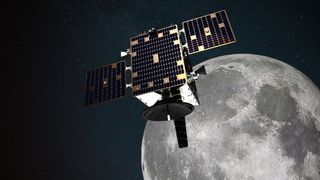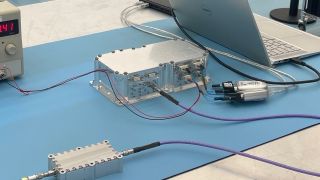This device will make GPS work on the moon

U.K. engineers are currently testing a device that will make GPS navigation work on the moon ahead of a 2024 launch of a demonstration mission.
The device, called NaviMoon, was built by Switzerland-based company Space PNT for the European Space Agency (ESA), which funds the mission, and is hailed as a breakthrough in lunar navigation.
"Today, to determine the position of a spacecraft on the moon we use parabolic antennas that are on Earth," Cyril Botteron, the CEO and co-founder of Space PNT, told Space.com. "But as Earth rotates, you need many stations, and also some rather expensive technologies on the satellites. Using a simple GPS receiver will make the process much cheaper."
However, to make GPS navigation work on the moon is no small feat. There are currently 31 satellites in the U.S. GPS constellation orbiting Earth at the altitude of 12,540 miles (20,180 kilometers), together with 22 European Galileo satellites at 14,430 miles (23,222 km). The moon, however, is on average 239,220 miles (385,000 km) away from Earth. On top of that, the GPS and Galileo navigation satellites are geared to beam their signal toward the planet, so whatever reaches the moon is just a "spillover," said Botteron.
Related: Every mission to the moon
"The [GPS] signal [that reaches the moon] is 1,000 times weaker than on Earth," Botteron said. "On top of that, the signal only comes from one side, whereas on Earth, you are surrounded by those satellites on all sides."
Still, the engineers believe NaviMoon will be able to determine the position of a satellite orbiting the moon with the accuracy of 330 feet (100 meters), which is better than what existing technologies can achieve.
Get the Space.com Newsletter
Breaking space news, the latest updates on rocket launches, skywatching events and more!
Using the NaviMoon system, engineers can virtually extend GPS coverage to the surface of the moon. First, they use the NaviMoon system on the satellite to determine the position of the satellite, then beam the signal on to the rovers and astronauts on the surface. With a constellation of four or five such satellites, Botteron said, they can achieve full coverage including the moon's dark side.
"What that technology will enable us basically to do, is to locate satellites orbiting the moon, and these satellites will then act as GPS or Galileo satellites for the moon user," Botteron said. "Already a small constellation of four or five satellites [equipped with NaviMoon receivers] will be enough to provide good services to the moon users to support landing on the moon, launching from the moon and lunar operations."

Space PNT has recently delivered an engineering model of the NaviMoon receiver to the U.K. company Surrey Satellite Technology (SSTL), which builds the Lunar Pathfinder spacecraft.
The NaviMoon engineering model is a functional replica of the flight model and will be used for testing before the delivery of the flight model, later this year.
The mission, described as the first step to establishing a telecommunications and navigation network around the moon, is expected to launch in late 2024 or early 2025, according to Nelly Offord, business development manager for the Lunar Pathfinder mission at SSTL.
In addition to NaviMoon, the Lunar Pathfinder spacecraft will carry a range of telecommunication systems that SSTL plans to use to sell services to users including space agencies and commercial companies preparing to operate their vehicles on the lunar surface.
"[Lunar Pathfinder] could transmit pictures that lunar rovers are taking, recorded scientific data, any type of data that the customer wants to retrieve from the surface or the orbit of the moon," Offord told Space.com.
Follow Tereza Pultarova on Twitter @TerezaPultarova. Follow us on Twitter @Spacedotcom and on Facebook.
Join our Space Forums to keep talking space on the latest missions, night sky and more! And if you have a news tip, correction or comment, let us know at: community@space.com.

Tereza is a London-based science and technology journalist, aspiring fiction writer and amateur gymnast. Originally from Prague, the Czech Republic, she spent the first seven years of her career working as a reporter, script-writer and presenter for various TV programmes of the Czech Public Service Television. She later took a career break to pursue further education and added a Master's in Science from the International Space University, France, to her Bachelor's in Journalism and Master's in Cultural Anthropology from Prague's Charles University. She worked as a reporter at the Engineering and Technology magazine, freelanced for a range of publications including Live Science, Space.com, Professional Engineering, Via Satellite and Space News and served as a maternity cover science editor at the European Space Agency.
